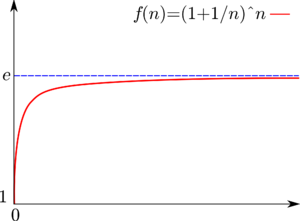Limit of a function: Difference between revisions
imported>Igor Grešovnik m (added See also) |
mNo edit summary |
||
| (8 intermediate revisions by 2 users not shown) | |||
| Line 1: | Line 1: | ||
{{subpages}} | |||
{{Image|Plot-e.png|right|300px|The function <math>(1 + \tfrac{1}{n})^n</math> tends towards <math>e</math> as <math>n</math> tends towards infinity.}} | |||
In [[mathematics]], the concept of a '''limit''' is used to describe the behavior of a [[function (mathematics)|function]] as its [[argument]] either "gets close" to some point, or as it becomes arbitrarily large. | In [[mathematics]], the concept of a '''limit''' is used to describe the behavior of a [[function (mathematics)|function]] as its [[argument]] either "gets close" to some point, or as it becomes arbitrarily large. | ||
Suppose ''f''(''x'') is a [[real-valued function]] and ''a'' is a [[real number]]. The expression | |||
:<math> \lim_{x \to a}f(x) = L </math> | |||
means that ''f''(''x'') can be made arbitrarily close to ''L'' by making ''x'' sufficiently close to ''a''. We say that "the limit of the function ''f'' of ''x'', as ''x'' approaches ''a'', is ''L''". This does not necessarily mean that ''f''(''a'') is equal to ''L'', or that the function is even defined at the point ''a''. | |||
Limit of a function can in some cases be defined even at values of the argument at which the function itself is not defined. For example, | |||
:<math> \lim_{x \to 0}\frac{\sin(x)}{x} = 1 , </math> | |||
although the function | |||
:<math> f(x)=\frac{\sin(x)}{x} </math> | |||
is not defined at ''x''=0. | |||
=== Formal definition=== | |||
Let ''f'' be a function defined on an [[open interval]] containing ''a'' (except possibly at ''a'') and let ''L'' be a [[real number]]. | |||
:<math> \lim_{x \to a}f(x) = L </math> | |||
means that | |||
:for each real ε > 0 there exists a real δ > 0 such that for all ''x'' with 0 < |''x'' − ''a''| < δ, we have |''f''(''x'') − ''L''| < ε. | |||
This formal definition of function limit is due to the German mathematician [[Karl Weierstrass]]. | |||
== See also == | == See also == | ||
* [[Limit (mathematics)]] | * [[Limit (mathematics)]] | ||
*[[Limit of a sequence]] | *[[Limit of a sequence]][[Category:Suggestion Bot Tag]] | ||
Latest revision as of 06:00, 12 September 2024
In mathematics, the concept of a limit is used to describe the behavior of a function as its argument either "gets close" to some point, or as it becomes arbitrarily large.
Suppose f(x) is a real-valued function and a is a real number. The expression
means that f(x) can be made arbitrarily close to L by making x sufficiently close to a. We say that "the limit of the function f of x, as x approaches a, is L". This does not necessarily mean that f(a) is equal to L, or that the function is even defined at the point a.
Limit of a function can in some cases be defined even at values of the argument at which the function itself is not defined. For example,
although the function
is not defined at x=0.
Formal definition
Let f be a function defined on an open interval containing a (except possibly at a) and let L be a real number.
means that
- for each real ε > 0 there exists a real δ > 0 such that for all x with 0 < |x − a| < δ, we have |f(x) − L| < ε.
This formal definition of function limit is due to the German mathematician Karl Weierstrass.






